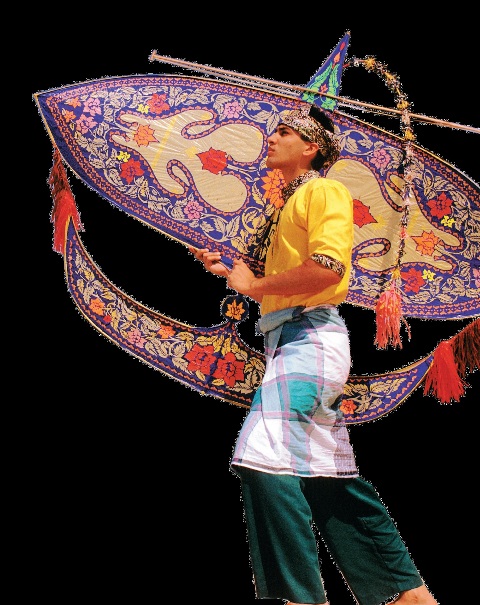
Back in the good ol’ days, dusk was a time cherished by boys and girls of all ages as it let them come together and have fun indulging in simple games that unified the children as one. Popular games of yesteryear include konda kondi, wau, gasing,and batu seremban, among others. While many of these games have lost a bit of lustre to virtual games, some of these parts of Malaysian heritage have stood the test of time and are still played in remote areas around the country today.
Wau is one of the traditional activites that is celebrated in grandeur and is a tradition inherent to the culture of the people in the eastern states of Peninsular Malaysia. Today, the kite is still widely found in the traditionally rich states of Kelantan and Terengganu, especially during harvest time. The word wau is believed to have derived from the Arabic letter ‘wau’ because the shape of the wing resembles the outline of that particular letter. Other hunches suggest the word wau originated from the Dutch word for a large fork-tail bird typical of Southeast Asia, to an early Westerner claiming to have exclaimed ‘wow’ upon witnessing the beauty of these kites.
Whatever the legends may be, the wau was in the past used by farmers as a sort of flying scarecrow to ward off birds from their paddy fields. The sound made by the wau once it was airborne was said to lull their children to sleep which in turn gave the farmers ample time to tend to their crops without distractions. Wau, with their delicate paper form and intricate floral designs, are visually enchanting and steeped in history and tradition. Today, events like the Pasir Gudang World Kite Festival and Kelantan International Wau Festival help spread the beauty of wau. Some wau are so large, they require more than one person to get them airborne.
There are more than 20 different varieties of wau, but the wau bulan is the most common. It is known as the “moon kite” for its curved, crescent moon shape. Hailing from the state of Kelantan, the wau bulan also has the status of being one of Malaysia’s national symbols, as such; it was featured on the reverse side of the Malaysian 50-cent coin in 1989. On some moon kites, there are blank spaces on either side which are called the ‘eyes.’ According to folklore, these help guide the kite in flight.
In making a wau, bamboo is used for the frame. The bamboo is split and soaked in mud for two weeks. This prevents the bamboo from being attacked by weevils as well making it more flexible. The bamboo splits are made into a complex but lightweight frame, tested with one layer of paper. Alterations are then made accordingly to make sure the kite is structurally sound. Next, the patterns are meticulously cut from rice paper and glued on piece by piece to form intricate motifs. Apart from the performance and appearance of the Malay kite, the sound is considered important as well. The sound created, or dengung as it is called, depends on the force of the wind. The higher the kite flies and the faster the wind, the higher the pitch.
Homepage Highlight Photo credit: rayleephoto / Foter / Creative Commons Attribution-NonCommercial-ShareAlike 2.0 Generic (CC BY-NC-SA 2.0)
Source: The Expat Magazine June 2014
Read more:
- 7 Unique Paintings by a Malaysian Artist
- How to Cut a Mango
- Two Traditional Malaysian Games You Should Know
What are your thoughts on this article? Let us know by commenting below.No registration needed.
"ExpatGo welcomes and encourages comments, input, and divergent opinions. However, we kindly request that you use suitable language in your comments, and refrain from any sort of personal attack, hate speech, or disparaging rhetoric. Comments not in line with this are subject to removal from the site. "




















